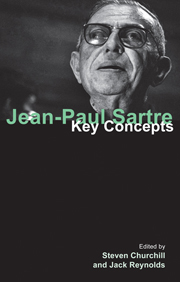Book contents
- Frontmatter
- Contents
- Contributors
- Acknowledgements
- Note on abbreviations
- 1 Introduction: Sartre vivant
- 2 Life and works
- Part I PSYCHOLOGY, PSYCHOANALYSIS AND LITERATURE
- Part II ONTOLOGY: FREEDOM, AUTHENTICITY AND SELF-CREATION
- 8 Nothingness and negation
- 9 The look
- 10 Bad faith
- 11 Authenticity
- 12 Knowledge
- 13 The fundamental project
- 14 Self-making and alienation: from bad faith to revolution
- Part III ETHICS AND POLITICS
- Bibliography
- Index
11 - Authenticity
from Part II - ONTOLOGY: FREEDOM, AUTHENTICITY AND SELF-CREATION
- Frontmatter
- Contents
- Contributors
- Acknowledgements
- Note on abbreviations
- 1 Introduction: Sartre vivant
- 2 Life and works
- Part I PSYCHOLOGY, PSYCHOANALYSIS AND LITERATURE
- Part II ONTOLOGY: FREEDOM, AUTHENTICITY AND SELF-CREATION
- 8 Nothingness and negation
- 9 The look
- 10 Bad faith
- 11 Authenticity
- 12 Knowledge
- 13 The fundamental project
- 14 Self-making and alienation: from bad faith to revolution
- Part III ETHICS AND POLITICS
- Bibliography
- Index
Summary
Introduction
Sartre's concern with individual authenticity pervades his early philosophical and literary writings. Yet his conception of authenticity is somewhat elusive. The only significant point he makes directly about authenticity in Being and Nothingness is in a footnote. There, he tells us that authenticity is the opposite of bad faith, but goes on to say that the description of authenticity “has no place here” (BN1: 70n; BN2: 94n). In two immediately subsequent works, Existentialism Is a Humanism and Anti-Semite and Jew, Sartre argues that authenticity is the fundamental virtue in his ethical outlook and he characterizes various examples of authentic and inauthentic ways of living, but in neither work does he give a clear explication of the idea of authenticity itself. His notes from that period, posthumously published as Notebooks for an Ethics (Sartre 1983b, 1992), make it abundantly clear that he intended to construct a complete account of ethics on the basis of authenticity, but since that project never came to fruition we are left without a detailed statement of the idea itself that Sartre considered worthy of publication.
Despite this, a commitment to the importance of authenticity drives Sartre's existentialism. It does so primarily through an exploration of its absence. In plays and novels as well as in Being and Nothingness, Sartre explores the ways in which people fail to be authentic and the damage this causes to their own lives and to the lives of those they affect.
- Type
- Chapter
- Information
- Jean-Paul SartreKey Concepts, pp. 131 - 142Publisher: Acumen PublishingPrint publication year: 2013



